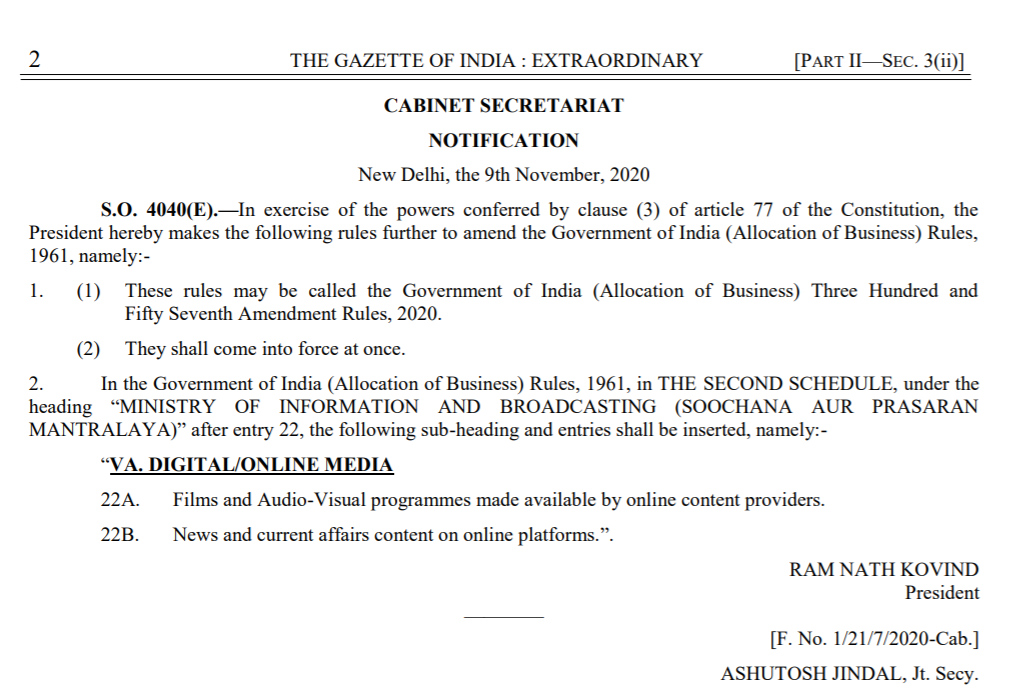Indian government has ordered that digital media --- including news websites and streaming platforms like Netflix and Amazon Prime --- will now come under the purview of the Union Ministry of Information and Broadcasting.
So far there was no specific law for digital content providers and news platforms, and the segment was not directly regulated by any particular ministry. The Information Technology Act, 2000 was the one that kind of gave an overarching legal framework for it.
The new government order, signed by the Indian President, comes into effect immediately.
- Where to watch the La Liga matches from India
- 5 cricket movies and series to keep you company
- 6 interesting offerings on Indian OTT platforms
Govt wanted regulations for OTT platforms
The latest development was always on the cards as the government was pushing for the same.
In July this year, Secretary in Ministry of Information and Broadcasting Amit Khare had been quoted as saying, "OTT being a digital platform will fall under the purview of the Ministry of IT but now we are proposing a decision that the content should fall within the purview of I&B ministry".
He added: "there is a need for convergence of various ministries (in this regard), particularly in the ways changes are happening, (it) is extremely necessary.”
The government was particularly concerned that out of the “five different media — print, radio, TV, films and OTT — four of them have certain kinds of regulatory practices and one is unregulated”.
Further, the I&B ministry had rejected the self regulation model proposed by 15 top OTTs that had internal representatives and an external domain expert to address complaints.
India has provisions under the Technology Act of 2000 to regulate content on news channels and websites with the powers to block them under Section 69A of the Act, but the same aren't yet expanded to include the OTT platforms.
In recent times, the federal government has blocked websites for content that posed a risk to India's sovereignty , on issues related to its defense and security.
Now the I&B Ministry will have more authority to wield against the OTT platforms too, many of whom till now felt the ministry lacked the legislative powers to control them.
Interestingly, user-generated content, such as what is streamed on YouTube or Facebook, will continue to remain under the Ministry of Electronics and Information Technology (MeitY).
What happens to OTT platforms now?

But, in a sense, the government may have been pushed by the courts in this direction. In a few cases against the content on OTT platforms, the court had told the ministry to come up with a system to address the various complaints.
Without the Ministerial relevance how could the I&B Ministry could have come up with a redressal mechanism? Ergo, the latest government order that pushed the OTT platforms under the ambit of the I&B Ministry, which in the past is known to have been overbearing and touchy to criticism.
So does that mean there will be censorship for the content on OTT platforms?
It is difficult to answer the question with any amount of clarity. But, in general, anything that goes under the purview of a governmental body tends to suffer from some form of control.
But the fact of the matter is in a conservative country like India, despite the growing openness, there is some queasiness over some of the content available on some OTT platforms.
It is not politically sensitive content alone that had lead to raised eyebrows. Some sexually explicit material had also drawn the ire of people and powers that be.
In the event, digital content monitoring will be in the hands of bureaucrats of the I&B ministry. It is an unsavoury prospect, but was also inevitable, in a sense.
November 11, 2020 at 09:15AM from TechRadar - All the latest technology news https://ift.tt/3pi9JCD
via IFTTT

No comments:
Post a Comment